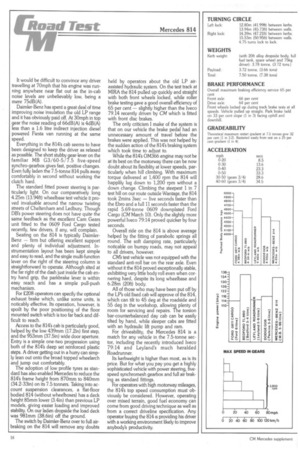Road Test Mercedes 814 It would be difficult to convince
Page 144

If you've noticed an error in this article please click here to report it so we can fix it.
any driver travelling at 70mph that his engine was running anywhere near flat out as the in-cab noise levels are unbelievably low, being a mere 75dB(A).
Daimler-Benz has spent a great deal of time improving noise insulation the old LP range and it has obviously paid off. At 30mph in top gear the noise reading of 66dB(A) is 4dB(A) less than a 1.6 litre indirect injection diesel powered Fiesta van running at the same speed.
Everything in the 814's cab seems to have been designed to keep the driver as relaxed as possible. The short stubby gear-lever on the familiar MB G3/60-5/7.5 five-speed synchro-gearbox gives fast, positive changes. Even fully laden the 7.5-tonne 814 pulls away comfortably in second without working the clutch hard.
The standard fitted power steering is particularly light. On our comparatively long 4.25m (13.94ft) wheelbase test vehicle it proved invaluable around the narrow twisting streets of Cheltenham and Ledbury. Though DB's power steering does not have quite the same feedback as the excellent Cam Gears unit fitted to the 0609 Ford Cargo tested recently, few drivers, if any, will complain.
Seating on the 814 is typically DaimlerBenz firm but offering excellent support and plenty of individual adjustment. Instrumentation layout has been kept simple and easy to read, and the single multi-function lever on the right of the steering column is straightforward to operate. Although sited at the far right of the dash just inside the cab entry hand grip, the parkbrake lever is within easy reach and has a simple pull-push mechanism.
For E208 operators can specify the optional exhaust brake which, unlike some units, is noticably effective. Its operation, however, is spoilt by the poor positioning of the floor mounted switch which is too far back and difficult to reach.
Access to the 814's cab is particularly good, helped by the low 439mm (17.2in) first step, and the 953mm (37.5in) wide door aperture. Entry is a simple one-two progression using both of the 814's deep set reinforced plastic steps. A driver getting out in a hurry can simply lean out onto the broad topped wheelarch and jump out comfortably.
The adoption of low profile tyres as standard has also enabled Mercedes to reduce the 814's frame height from 870mm to 840mm (34.2-33in) on its 7.5 tonners. Taking into account suspension clearances, a flat-floor bodied 814 -(without wheelboxes) has a deck height 85mm lower (3.4in) than previous LP models, giving easier loading and improved stability. On our laden dropside the load deck was 981mm (38.6in) off the ground.
The switch by Daimler-Benz over to full airbraking on the 814 will remove any doubts held by operators about the old LP airassisted hydraulic system. On the test track at MIRA the 814 pulled up quickly and straight with both front wheels locked, while roller brake testing gave a good overall efficiency of 65 per cent slightly higher than the lveco 79.14 recently driven by CM which is fitted with front disc brakes.
The only criticism I make of the system is that on our vehicle the brake pedal had an unnecessary amount of travel before the brakes were applied. This was not helped by the sudden action of the 814's braking system which took time to adjust to.
While the 814's 0M366 engine may not be at its best on the motorway there can be now doubt about its flexiblity at lower speeds, particularly when hill climbing. With maximum torque delivered at 1,400 rpm the 814 will happlily lug down to 1,200 rpm without a down change. Climbing the steepest 1 in 7 test hill on our route outside Wantage, the 814 took 2mins 3sec five seconds faster than the Ebro and a full 11 seconds faster than the rapid 5.69-tonne 0609 downplated Ford Cargo (CM March 10). Only the slightly more powerful Iveco 79:14 proved quicker by four seconds.
Overall ride on the 814 is above average helped by the fitting of parabolic springs all round. The soft damping rate, particularly noticable on bumpy roads, may not appeal to all drivers, however.
CM's test vehicle was not equipped with the standard anti-roll bar on the rear axle. Even without it the 814 proved exceptionally stable, exhibiting very little body roll even when cornering hard, despite its long wheelbase and 6.28m (20ft) body.
All of those who may have been put off by the LP's old fixed cab will approve of the 814, which can tilt to 45 deg at the roadside and 55 deg in the workshop, allowing plenty of room for servicing and repairs. The torsion bar-counterbalanced day cab can be easily tilted by hand, while sleeper cabs are fitted with an hydraulic lift pump and ram.
For driveability, the Mercedes 814 is a match for any vehicle in the 7.5-tonne sector, including the recently introduced lveco 79:14 and Leyland's much heralded Roadrunner.
Its kerbweight is higher than most, as is its price. But for what you pay you get a highly sophisticated vehicle with power steering, fivespeed synchromesh gearbox and full air braking as standard fittings.
For operators with high motorway mileages, the 814's top speed consumption must obviously be considered. However, operating over mixed terrain, good fuel economy can come from good driving technique as well as from a correct driveline specification. Any operator buying the 814 is providing his driver with a working environment likely to improve anybody's productivity.




























































































































































